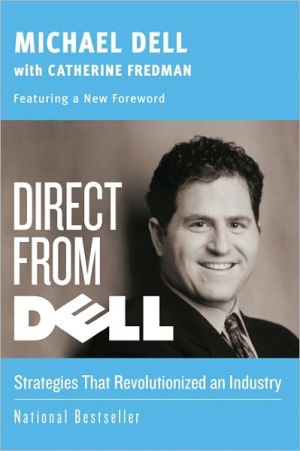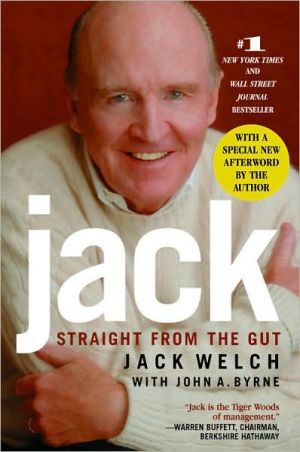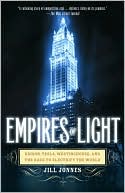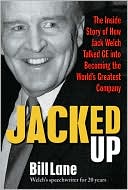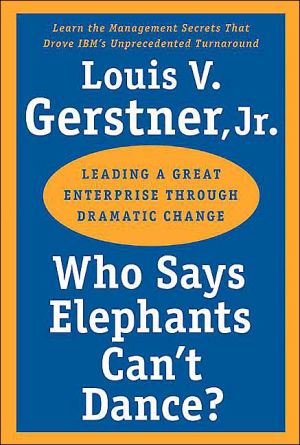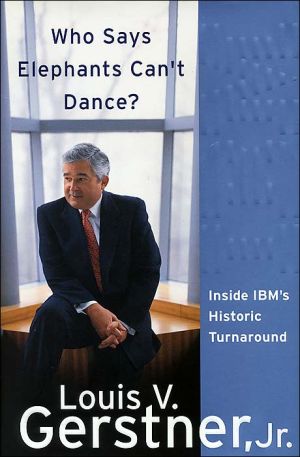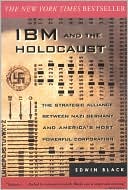Direct from Dell: Strategies That Revolutionized an Industry
At nineteen, Michael Dell started his company as a freshman at the University of Texas with $1,000 and has since built an industry powerhouse. As Dell journeys through his childhood adventures, ups and downs, and mistakes made along the way, he reflects on invaluable lessons learned.\ Michael Dell's revolutionary insight has allowed him to persevere against all odds, and Direct from Dell contains valuable information for any business leader. His strategies will show you effective ways to grow...
Search in google:
In 1983, Michael Dell, a freshman at the University of Texas at Austin, drove away from his parents' Houston home in a BMW he'd bought selling subscriptions to his hometown newspaper. In the backseat were three personal computers. Today, he is the chairman and CEO of Dell Computer Corporation, a $30 billion company and the second largest manufacturer and marketer of computers in the world. Founded on a deceptively simple premise-to deliver high-performance computer systems directly to the end user-Dell Computer is the envy of its competition. It has consistently grown at two to three times the industry rate, its stock went up more than 90,000 percent in the last decade, and Dell is now selling more than $35 million worth of systems per day over www.dell.com. In Direct from Dell, you will learn why it's better for any business starting out to have too little capital rather than too much why your people pose a greater threat to the health of your business than your competition how you can exploit your competition's weakness by exposing its greatest strength how intergrating your business virtually can make the difference between being quick -and being dead and much more
\ The Birth of Being Direct\ \ \ I first experienced the power--and the rewards--of being direct when I was twelve years old. The father of my best friend in Houston was a pretty avid stamp collector, so naturally my friend and I wanted to get into stamp collecting, too. To fund my interest in stamps, I got a job as a water boy in a Chinese restaurant two blocks from my house. I started reading stamp journals just for fun, and soon began noticing that prices were rising. Before long, my interest in stamps began to shift from the joy of collecting to the idea that there was something here that my mother, a stockbroker, would have termed "a commercial opportunity."\ In our household, you couldn't help being aware of commercial opportunities. The discussions at our dinner table in the 1970s were about what the chairman of the Federal Reserve was doing and how it affected the economy and the inflation rate; the oil crisis; which companies to invest in, and which stocks to sell and buy. The economy in Houston was booming at the time, and the market for collectibles was quite active. It was obvious to me from what I'd read and heard that the value of stamps was increasing, and being a fairly resourceful kid, I saw this as an opportunity.\ My friend and I had already bought stamps at an auction, and since I knew even then that people rarely did something for nothing, I assumed that the auctioneers were making a decent fee. Rather than pay them to buy the stamps, I thought it would be fun to create my own auction. Then I could learn even more about stamps and collect a commission in the process.\ I was about to embark upon one of my very first businessventures.\ First, I got a bunch of people in the neighborhood to consign their stamps to me. Then I advertised "Dell's Stamps" in Linn's Stamp Journal, the trade journal of the day. And then I typed, with one finger, a twelve-page catalog (I didn't yet know how to type, nor did I have a computer) and mailed it out.\ Much to my surprise, I made $2,000. And I learned an early, powerful lesson about the rewards of eliminating the middleman. I also learned that if you've got a good idea, it pays to do something about it.\ Seeing the Pattern\ A few years later, I saw the chance to seize an even greater opportunity. When I was sixteen, I got a summer job selling newspaper subscriptions to The Houston Post. At the time, the newspaper gave its salespeople a list of new phone numbers issued by the telephone company and told us to cold call them. It struck me as a pretty random way of approaching new business.\ I soon noticed a pattern, however, based on the feedback I was getting from potential customers during these conversations. There were two kinds of people who almost always bought subscriptions to the Post: people who had just married and people who had just moved into new houses or apartments. With this in mind, I wondered, "How could you find all the people who are getting mortgages or getting married?"\ After asking around, I discovered that when a couple wanted to get married, they had to go to the county courthouse and get a marriage license. They also had to provide the address to which the license would be sent. In the state of Texas, that information is public. So I hired a couple of my high school buddies and we canvassed the courthouses in the sixteen counties surrounding the Houston area, collecting the names and addresses of the newly (or soon-to-be-newly) married.\ Then I found out that certain companies compiled lists of people who had applied for mortgages. These lists were ranked by the size of the mortgage. You could easily identify the people with the largest mortgages and go after those high-potential customers first.* I targeted these people, creating a personalized letter and offering them a subscription to the newspaper.\ By this time, summer was over and it was time to go back to high school. As important as school was, I found that it could be very disruptive to a steady income. I had worked hard to create a lucrative system and didn't want to just throw it away, so I handled the bulk of the work during the week after school, and I did the follow-up work on Saturday mornings. The subscriptions came in by the thousands.\ One day, my history and economics teacher assigned us a project for which we had to file our tax returns. Based on what I had made selling newspaper subscriptions, my income was about $18,000 that year. At first, my teacher corrected me, assuming I had missed the decimal place. When she realized I hadn't, she became even more dismayed.\ To her surprise, I had made more money that year than she had.\ \ Direct from Dell. Copyright © by Michael Dell. Reprinted by permission of HarperCollins Publishers, Inc. All rights reserved. Available now wherever books are sold.
